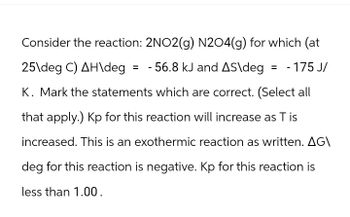
Chemistry
10th Edition
ISBN: 9781305957404
Author: Steven S. Zumdahl, Susan A. Zumdahl, Donald J. DeCoste
Publisher: Cengage Learning
expand_more
expand_more
format_list_bulleted
Question

Transcribed Image Text:Consider the reaction: 2NO2(g) N204(g) for which (at
25\deg C) AH\deg = -56.8 kJ and AS\deg = -175 J/
K. Mark the statements which are correct. (Select all
that apply.) Kp for this reaction will increase as T is
increased. This is an exothermic reaction as written. AG\
deg for this reaction is negative. Kp for this reaction is
less than 1.00.
Expert Solution
This question has been solved!
Explore an expertly crafted, step-by-step solution for a thorough understanding of key concepts.
This is a popular solution
Trending nowThis is a popular solution!
Step by stepSolved in 4 steps

Knowledge Booster
Learn more about
Need a deep-dive on the concept behind this application? Look no further. Learn more about this topic, chemistry and related others by exploring similar questions and additional content below.Similar questions
- Given the information A+ B 2D AH = -759.3 kJ AS = 368.0 J/K C→ D AH° = 432.0 kJ AS = -126.O J/K calculate AG at 298 K for the reaction A +B 2C AG = 1808.06 Incorrect Activate Windo Go to Settings to actro help terms of use contact us careers privacy policy about usarrow_forward[Review Topilos] 10Refaeiyas Use the References to access important values if needed for this question. Consider the following system at equilibrium where AH° = -10.4 kJ, and K. = 55.6 , at 698 K: H2 (g) + I2 (g)= 2 HI (g) If the TEMPERATURE on the equilibrium system is suddenly increased The value of K. A. Increases B. Decreases C. Remains the same The value of Q. A. Is greater than K. B. Is equal to K. C. Is less than K. The reaction must: A. Run in the forward direction to restablish equilibrium. B. Run in the reverse direction to restablish equilibrium. C. Remain the same. Already at equilibrium. The concentration of I, will: A. Increase. B. Decrease, C. Remain the same. Submit Answer Retry Entire Group 9 more group attempts remaining Prev 50arrow_forward48 Use data to compute ΔG° at 57.0°C for the following reaction. 2ClO2−(aq) + O2(g) → 2ClO3−(aq) ΔH°f (ClO2−(aq)) = -67 kJ mol-1ΔH°f (ClO3−(aq)) = -104 kJ mol-1ΔS° (ClO2−(aq)) = 101 J mol-1 K-1ΔS° (O2(g)) = 205.152 J mol-1 K-1ΔS° (ClO3−(aq)) = 162 J mol-1 K-1ΔG°f (ClO2−(aq)) = 17 kJ mol-1ΔG°f (ClO3−(aq)) = -3 kJ mol-1arrow_forward
- Given the following and that R= 8.314 J/K mol, determine the equilibrium constant, K, at 298K for the following reaction: AgI(s)→ Ag (aq) + (aq) Substance (aq) Ag (aq) AgI(s) AG (kJ/mol) at 298 K 51.59 77.12 -66.2arrow_forwardFor the reaction2NO(g) + O2(g)2NO2(g)H° = -114.2 kJ and S° = -146.5 J/KThe equilibrium constant for this reaction at 337.0 K isarrow_forwardplease help! use correct sig figs and/or scientific notation! Multiple part question and very confused. Also, at the end what would be the equilibrium constant for this reaction at 2500 ºC.arrow_forward
- For the reaction Fe3O4 (s) + 4H2(g) → 3Fe(s) + 4H₂O(g) AH° = 151 kJ and AS° = 169 J/K The equilibrium constant for this reaction at 342.0 K is Assume that AH° and AS are independent of temperature.arrow_forwardFor the reaction 2HBr(g) + Cl₂ (g) → 2HCl(g) + Br₂ (g) AH = -81.1 kJ and AS° = -1.20 J/K The equilibrium constant for this reaction at 288.0 K is | Assume that ΔΗ° and AS are independent of temperature. Submit Answer Retry Entire Group 9 more group attempts remainingarrow_forwardFor a particular reaction, AH = -238.4 kJ and AS = -80.0 J/K. Calculate AG for this reaction at 298 K. AG = kJ What can be said about the spontaneity of the reaction at 298 K? The system is spontaneous in the reverse direction. The system is at equilibrium. The system is spontaneous as written.arrow_forward
arrow_back_ios
arrow_forward_ios
Recommended textbooks for you
 ChemistryChemistryISBN:9781305957404Author:Steven S. Zumdahl, Susan A. Zumdahl, Donald J. DeCostePublisher:Cengage Learning
ChemistryChemistryISBN:9781305957404Author:Steven S. Zumdahl, Susan A. Zumdahl, Donald J. DeCostePublisher:Cengage Learning ChemistryChemistryISBN:9781259911156Author:Raymond Chang Dr., Jason Overby ProfessorPublisher:McGraw-Hill Education
ChemistryChemistryISBN:9781259911156Author:Raymond Chang Dr., Jason Overby ProfessorPublisher:McGraw-Hill Education Principles of Instrumental AnalysisChemistryISBN:9781305577213Author:Douglas A. Skoog, F. James Holler, Stanley R. CrouchPublisher:Cengage Learning
Principles of Instrumental AnalysisChemistryISBN:9781305577213Author:Douglas A. Skoog, F. James Holler, Stanley R. CrouchPublisher:Cengage Learning Organic ChemistryChemistryISBN:9780078021558Author:Janice Gorzynski Smith Dr.Publisher:McGraw-Hill Education
Organic ChemistryChemistryISBN:9780078021558Author:Janice Gorzynski Smith Dr.Publisher:McGraw-Hill Education Chemistry: Principles and ReactionsChemistryISBN:9781305079373Author:William L. Masterton, Cecile N. HurleyPublisher:Cengage Learning
Chemistry: Principles and ReactionsChemistryISBN:9781305079373Author:William L. Masterton, Cecile N. HurleyPublisher:Cengage Learning Elementary Principles of Chemical Processes, Bind...ChemistryISBN:9781118431221Author:Richard M. Felder, Ronald W. Rousseau, Lisa G. BullardPublisher:WILEY
Elementary Principles of Chemical Processes, Bind...ChemistryISBN:9781118431221Author:Richard M. Felder, Ronald W. Rousseau, Lisa G. BullardPublisher:WILEY

Chemistry
Chemistry
ISBN:9781305957404
Author:Steven S. Zumdahl, Susan A. Zumdahl, Donald J. DeCoste
Publisher:Cengage Learning

Chemistry
Chemistry
ISBN:9781259911156
Author:Raymond Chang Dr., Jason Overby Professor
Publisher:McGraw-Hill Education

Principles of Instrumental Analysis
Chemistry
ISBN:9781305577213
Author:Douglas A. Skoog, F. James Holler, Stanley R. Crouch
Publisher:Cengage Learning

Organic Chemistry
Chemistry
ISBN:9780078021558
Author:Janice Gorzynski Smith Dr.
Publisher:McGraw-Hill Education

Chemistry: Principles and Reactions
Chemistry
ISBN:9781305079373
Author:William L. Masterton, Cecile N. Hurley
Publisher:Cengage Learning

Elementary Principles of Chemical Processes, Bind...
Chemistry
ISBN:9781118431221
Author:Richard M. Felder, Ronald W. Rousseau, Lisa G. Bullard
Publisher:WILEY